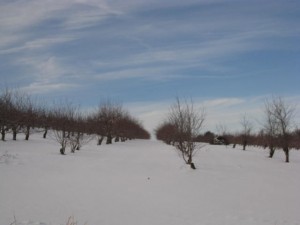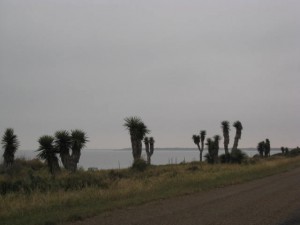Although the Weather Channel predicted that the high today would be around 15 degrees, the sun shone brightly in a cloudless blue sky all morning, and shortly after lunch, I felt compelled to venture outside. So I stuffed my cross-country skis, poles, and boots into my car and drove a bit over a mile to Brookfield Orchards. Many years ago, the Orchard groomed cross-country ski trails, and although they no longer cut tracks for skiers, I thought they might allow me to go out on their land. I checked at the Country Store, and they said, “Sure, you’re welcome to ski here.”
Last week when this blizzard dumped almost two feet of snow on New England, I was shivering in South Texas and didn’t really have a sense of how much snow fell on my hometown. Well, there is still a lot of the white stuff, perhaps because the temperatures haven’t risen enough to melt much of it.
I cut this track going downhill from the picnic area:

On the north side of Lincoln Street, I could see another skier’s tracks:

These look to me like snowshoe tracks:

This photo should indicate that I really am in an orchard.

My older sister and brother-in-law gave me these cross-country skis for Christmas in 1977, which means I’ve owned them for over thirty-three years. They are Fisher fiberglass skis which need to be waxed. Today I chose green, and half-way through my outing, I stopped to re-wax with blue under my boots. I’m not sure those were the right colors, but I don’t think I did that badly, considering that I ski once every ten years or so. And what a great time I had!
Now let us take a moment to remember the Reverend Dr Martin Luther King Jr, in whose honor we are enjoying a holiday today. On the CBS Evening News tonight, I watched an interesting segment describing Dr King’s two summers working in the tobacco fields of the Connecticut River Valley; I don’t think I even knew he was associated with Simsbury, Connecticut.







